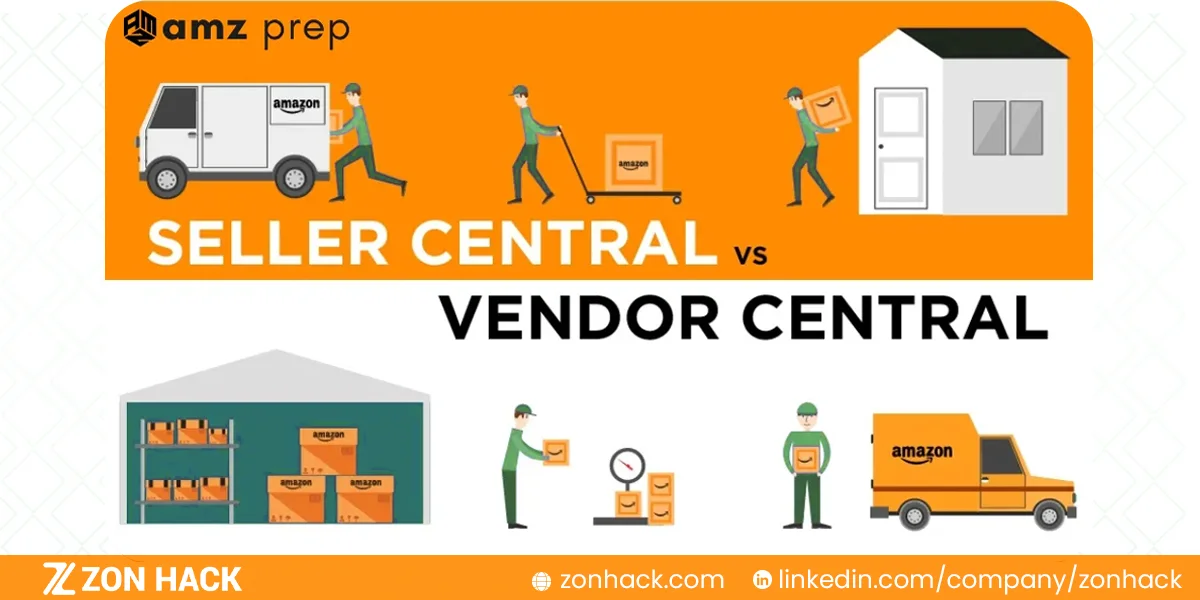Choosing between Amazon Vendor Central and Amazon Seller Central is one of the many Amazon fulfillment choices available to you when you sell on Amazon. The point of contact who actually sells your items is the primary distinction between Amazon Vendor Central and Amazon Seller Central. If you choose Vendor Central, Amazon will purchase your products from you and resell them to its buyers. You can offer your products to customers directly through the Amazon marketplace by using Seller Central.
This post aims to provide you with a comprehensive understanding of the advantages, disadvantages, and complete extent of each so you can decide which choice best meets the demands of your business.
Quick View
- What is Amazon Seller Central?
- Amazon Seller Central features
- What is Amazon Vendor Central?
- Amazon Vendor Central features
- Amazon Vendor Central vs Seller Central
- Pros & cons of Amazon Seller Central
- Pros & cons of Amazon Vendor Central
- Summary
What Is Amazon Seller Central?
Seller Central is Amazon’s dashboard for third-party sellers. Said differently, each independent seller wishing to sell on Amazon has to register for a seller central account in order to manage inventory and carry out other business-related duties. Anyone can launch an Amazon business using Seller Central and not have to bother with things like website design, payment processing, and return processing.
Amazon Seller Central Services
- Amazon Fulfilled by Amazon (FBA)
- Amazon Fulfilled by Merchant (FBM)
- Amazon Seller Fulfillment Prime (SFP)
- Amazon Multi-Channel Fulfillment (MCF or Buy with Prime)
Amazon Seller Central Features
- Open to anyone
- Control of the seller account
- Sell directly to Amazon’s customers
- Flexible logistical options
- Quick payment terms
- Brand controls retail pricing
- Limited advertising options
- Complex sales process
- Enhanced Brand Content
What Is Amazon Vendor Central?
Amazon’s first-party selling platform is called Vendor Central. Entrepreneurs who sell their goods directly to Amazon as wholesalers are known as first-party sellers or vendors. Vendor Central allows you to sell to Amazon as a business-to-business (B2B) company, but Seller Central allows you to sell directly to customers (Seller Central is a B2C platform).
The vendor central program can only be used via invitation. In other words, sellers who are qualified to be Amazon vendors receive exclusive invites from Amazon, and only those who fulfill the conditions can be accepted as vendors. Here are the steps involved in becoming a vendor:
- You wait for Amazon to request your items after receiving an invitation.
- Fill out the purchase order form that will be sent to you.
- Amazon gets the product and manages the sales process.
Amazon Vendor Central Features
- Invite only
- Sell to Amazon in bulk
- Fixed logistical options
- Traditional payment terms
- Amazon controls retail pricing
- Multiple advertising options
- Traditional sales process
- A+ content
Amazon Vendor Central vs Seller Central
| Amazon Vendor Central | Amazon Seller Central |
| Invite only | Open to anyone |
| Brands can only sell to Amazon | Brands can sell directly to customers |
| Retail price is controlled by Amazon | Retail Price is controlled by Sellers |
| Amazon handles fulfillment | Sellers get flexible fulfillment |
| Traditional sales process | Complex sales process |
| Several ads options | Limited ad options |
| A+ content | Limited brand content |
Pros & Cons Of Amazon Seller Central
Pros
Analytical data
Independent sellers can easily obtain a vast quantity of customer data from Amazon through their seller central dashboard, which is available to them for free. Typically, this data includes customer information and trending products and can be used as a model for important business decisions such as choosing an Amazon warehouse or a logistics company.
Pricing control
You, as the seller, are in charge of the pricing you set, so you can keep uniformity even if you are selling through retail channels other than Amazon. Moreover, if you need to adjust your pricing to match a competitor, that can be enabled automatically.
Flexible logistic options
Fulfillment by Amazon (Amazon FBA) or Fulfillment by Merchant (FBM) are the two options available to independent sellers. Both alternatives provide sellers the chance to have a great deal of control over their branding. However, sellers who use the FBM option may have to pay extra charges for shipping and storage.
Inventory control
Being able to adapt to the demands of your shoppers can make or break any small to medium-sized business. This is particularly valid if you produce a limited quantity of products. You can adapt to market needs (customers or vendors) if you have physical control of your own inventory.
Access to a large customer base
Sellers have access to Amazon’s customer base of over 300 million shoppers, which ensures a steady demand for their products. Additionally, sellers can increase their audience reach and sales by utilizing Amazon advertising as a tactic.
Cons
Increased costs
In addition to the selling fees that third-party sellers must pay, FBM sellers also have to bear shipping and storage costs. FBA sellers are not left out, and they will also be required to pay a number of FBA fees, mostly storage, fulfillment, and referral fees.
Sales and marketing
For many sellers, it is imperative to handle their own sales and marketing, yet some sellers may lack the resources or expertise to do so. Similar to any other stand-alone store in the Amazon marketplace, the seller must continuously maintain the store by updating the product description, advertising their products through different channels, and monitoring customer behavior.
More responsibility
Sellers need to conduct product research, keyword research, inventory management, and listing optimization in order to generate sales. These processes may be time-consuming and exhausting. However, sellers can use FBA software to automate them.
Pros & cons of Amazon Vendor Central
Pros
Customer confidence
Due to Amazon’s name recognition, selling your products through Vendor Central as a first-party seller guarantees customer confidence. Choosing the Amazon platform over a less-known third-party website will probably provide customers with more assurance and confidence when placing orders.
Expanded advertising opportunities
Brands can obtain a strong tool with a variety of choices for placing products in front of customers with Amazon Marketing Services (AMS). It enables sellers to drive demand through keyword-targeted ad campaigns that aim to draw more customers to certain product pages on Amazon. Vendor Central offers more powerful options for using AMS to run ad campaigns, although AMS is accessible to both sellers and vendors.
Simplified business model
Working with Vendor Central is simpler than it is with Seller Central. A vendor’s main concern is to fulfill orders and fix prices. Third-party sellers, on the other hand, are responsible for several additional duties. Also, having Amazon as your sole customer makes running your business easier. Third-party sellers who have to sell to hundreds of customers may find it difficult to manage their business.
Additional Tools
Exclusive promotional programs are available to first-party sellers. For example, they can take part in the Subscribe and Save program. Vendors are also able to sign up for Amazon Vine. Vendors can get reviews from trusted reviewers through the Vine program. Given the significance of reviews, vendors should consider investing in the Vine program.
Cons
Price control
Minimum Advertised Pricing (MAP) standards from manufacturers are not strictly followed by Amazon. Amazon has the ability to change its selling prices at any time based on its internal algorithms.
Logistical needs
Amazon has specific and strict order processing policies. Sellers who find it difficult to keep up inventory levels or quickly fulfill orders may face large chargebacks, which can significantly reduce their profits.
Lack of sales channel diversification
In many cases, Amazon is the leading buyer for many sellers. Relying on a single buyer is also risky for vendors. Experienced sellers want multiple sales channels, and most purchases come from their own e-commerce storefront. Amazon discontinued purchasing from a number of vendors suddenly without prior notice or explanation at the beginning of 2019. This left a lot of sellers who needed help to make up for missed sales.
Loss of brand control
Customers of Amazon trust the main products of vendors, but vendors have no control over them. Vendors no longer have control over their branding when Amazon repackages the products. Most buyers choose to purchase straight from Amazon because they are unaware of the real manufacturers of these items. Therefore, vendors are unable to establish a reputable brand on their own.
Summary
Do you want to maximize your income but are unsure whether Amazon Seller Central or Vendor Central would suit you better? Since you are directly involved in the sales process with Amazon Seller Central, there is a substantial possibility for higher profits. You can control the pricing and profit margins by getting rid of middlemen and managing the sales process. Conversely, brands sell their products to Amazon in bulk through Vendor Central, and Amazon sets the profit margin.
As a result, you could have less workload, but your profit margin might also be affected. In contrast to Seller Central, Vendor Central is more suited for bulk sellers if you are an individual seller with individual customers and Amazon handles shipping. To sum up, there are benefits to both Amazon Seller Central and Vendor Central. Vendor Central is best for bulk dealers who want less stress and have Amazon handle the fulfillment, whereas Seller Central offers more control and higher margins.




